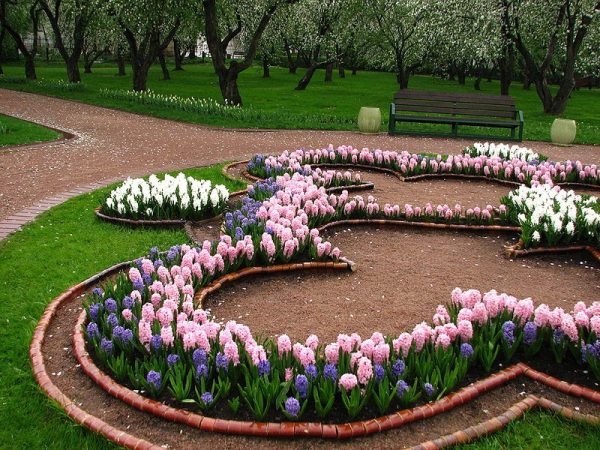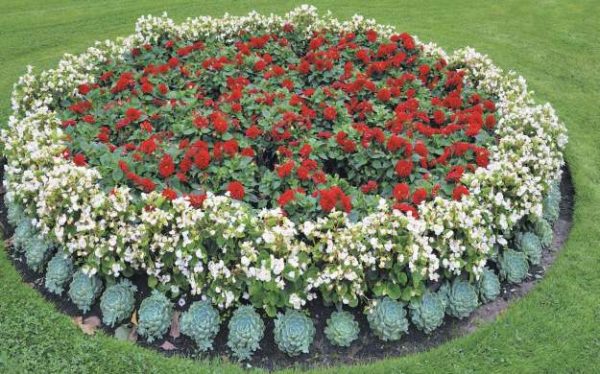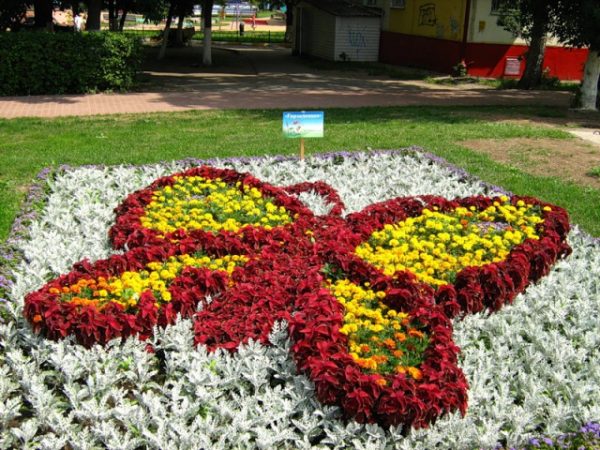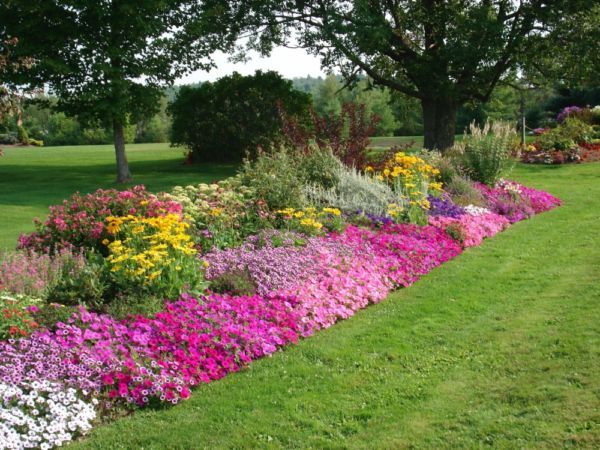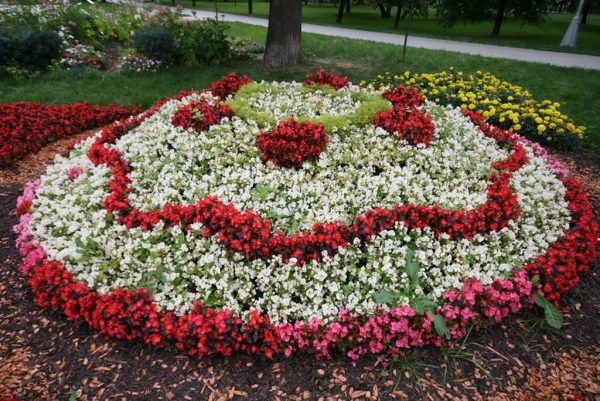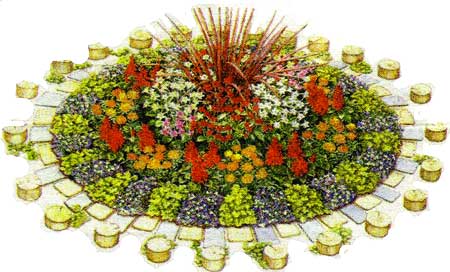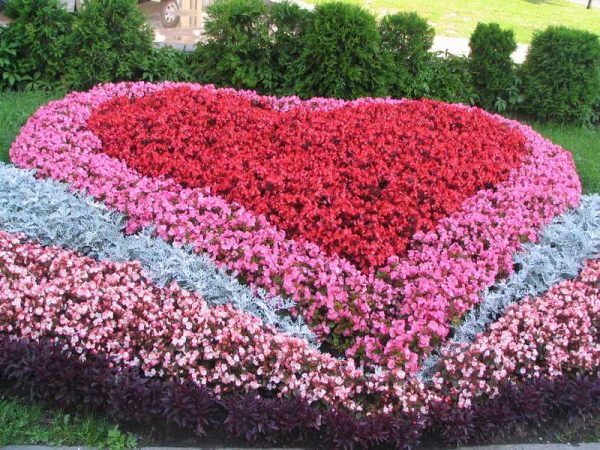Types of flower beds: what are there and how to do it yourself
Content
Regular flower bed
Regular flower beds are often found in city parks, in the territories of offices and institutions. The main difference between such compositions is strict geometric shapes, a symmetrical pattern of flowers, where a clear border between plants and their color range is defined. For this type of flower bed, it is important that all flowers present in the composition bloom at the same time. The illumination of regular flower beds is of particular importance. They should be placed so that no shadow falls on the plants - only under this condition is the uniform flowering of flower arrangements possible.
Arranging a regular flower bed in the country is not often practiced, since its creation requires a large area where there is no shade from trees. But if the area allows, then organizing such a flower garden with your own hands will not be difficult. However, you need to understand that to maintain the aesthetic appearance of the composition, it will take a lot of time, as well as financial costs, since the plants will need to be regularly watered and fed. However, the result obtained compensates for all costs - with proper care, a regular flower bed looks really luxurious.
Video "Detailed instructions on how to make a flower garden"
Detailed video tutorial with helpful tips and tricks.
Irregular flower bed
This type of flower bed is characterized by the chaotic planting of flowers in small groups, which makes the flower garden more natural. Not a single site in the country can do without such a flower garden, since it is not difficult to take care of it, it does not require large financial investments, and the whole warm season pleases with flowering.
A distinctive feature of irregular flower beds is the absence of strict flower patterns - the planting zones of flowers can overlap and overlap. The composition can be of any size and shape. Also, there is no provision for the simultaneous flowering of plants. Usually flowers are selected so that the composition blooms in waves and for a long time - some flowers have faded, and others have blossomed to replace them. Arranging irregular flower beds with your own hands has some features:
- flower gardens also require good illumination, and care must be taken that taller plants do not shade lower ones;
- you need to plant flowers taking into account the cardinal points - all plants turn towards the sun, and if you have to admire the flower garden from the north side, then the heads of most flowers will be turned in the other direction;
- you also need to take into account the location of flower arrangements in relation to the paths, viewing platforms: in the foreground, low-growing flowers should grow, in the far - tall;
- if the flower bed is visible from all sides, then tall plants are planted in the center, and lower ones closer to the edge;
- it is important to take into account the period of their flowering when planting flowers - if you plant flowers of the same type, then when they fade, the flower bed will become empty and become unsightly, therefore it is recommended to plant many different plants, both annuals and perennials;
There are no clear rules and restrictions in creating irregular flower beds with your own hands - fantasize, experiment with colors. This will make the composition more natural and harmonious.
Carpet
Carpet beds are used mainly in urban landscape gardening, but even in the country, it is quite within the power of every owner of the property to create such a composition with their own hands. This type of flower garden is a living carpet with a clear pattern, composed of low-growing flowers with multi-colored foliage and a simultaneous flowering period. When the flowerbed blooms, it seems that this is a real fluffy carpet with original ornaments.
Carpet flower beds look very nice, but they need special care. When arranging flower arrangements in the country, you need to calculate your time so that at least once a week, the flower bed is given several hours of time for the following activities:
- it is necessary to ensure that the pattern is not disturbed (the plants did not go beyond the boundary line) - for this you need to regularly cut off the regrown shoots and flowers;
- you also need to remove dried inflorescences in time - otherwise the flower bed will look neglected;
- to maintain the proper appearance of the flowerbed, regular watering is required - if the composition was created using flower plants in pots, then watering should be carried out more often, since the soil in the pots dries out quickly.
The maintenance of a carpet flower bed in the country is a rather troublesome business, however, after spending a little time, in return you will receive a truly luxurious flower garden that guests and neighbors will admire.
Raised
For a raised flower bed, as the name implies, placement on a certain elevation is characteristic. In fact, this is a container for flowers, most often of the correct shape in the form of a square, rectangle, polyhedron. A distinctive feature of the flower bed is a border with a height of 20 cm, made of a variety of materials: boards, brick, concrete, stone, any improvised means.
Such a flower bed is usually located on a hard surface, at the main entrance, along the sidewalk, or walkway. At the dacha, you can install a raised structure in the backyard, in the recreation area, at the entrance to the house - a pair of symmetrical flower beds located in the front of the site looks very solemn. Arranging a raised flower garden with your own hands is within the power of even inexperienced flower growers. Having built a fence, you just need to fill up a drainage layer on which to lay the soil. If necessary, you can add a universal fertilizer to the soil. Next, we plant flowers - usually annuals are used for such beds.
Raised flower beds can be located in any container, reservoir. Some inventive summer residents arrange flower beds in old used furniture. Raised structures can be used to build multi-level and cascading compositions. It is important to understand that the soil in such containers dries out quickly, so the plants need regular watering.
Classic
Classic flower beds are most often used to decorate the landscape space in the country. This type of flower garden is characterized by the planting of flowers of one specific type, and sometimes color. Such flower beds, as a rule, are placed along the paths and are used to visually delineate zones.
When creating classic flower beds with your own hands, you need to carefully approach the choice of flower plants - they should be bright and decorative. Large flowers look perfect from a distance: dahlias, roses, peonies, tulips.Giving the flower garden a certain, better, correct shape will relieve the impression that the plants were planted spontaneously or accidentally.
Vertical
Vertical flower beds are ideal for landscaping small areas in the country, as well as for masking any unsightly areas or structures. In addition, blooming hedges as decoration for walls, fences, gazebos, garden arches are unlikely to leave anyone indifferent. Creating a vertical flower bed with your own hands is a laborious and responsible process. Indeed, when organizing such flower arrangements, you need to take into account many important points:
- choose the most suitable design for the flower garden, taking into account the shape, weight, material;
- to provide reliable fastening for the future flower bed;
- think over and, if necessary, lay an irrigation system;
- prepare the soil base and pick up the plants.
Weaving plants are used to create hedges or screens. For their growth, it is necessary to install a support - a frame made of wood, wire or thin rope. For the device of multi-tiered flower arrangements, it is necessary to purchase special plastic or metal lattices, multi-tiered boxes, material for hydroponics.
In containers for vertical flower beds, as a rule, curly or ampelous flowers are planted - they hang down, and during flowering form a living wall. If desired, a floral figured sculpture can be installed on the site. And so that the soil in an upright position does not spill out, it is better to use hydroponics for sculpture (a material that replaces soil). Of course, such a composition requires a lot of imagination and effort, but the result is worth it.
Video "Flower beds as an integral part of landscape design"
Demonstration video with various ideas.

